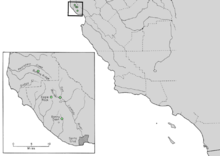Cupressus abramsiana
| Cupressus abramsiana | |
|---|---|
| | |
| Santa Cruz Cypress showing stunted growth due to nutrient and moisture-poor sandstone substrate at Majors Creek, Santa Cruz Co. Ca. | |
| Scientific classification | |
| Kingdom: | Plantae |
| Division: | Pinophyta |
| Class: | Pinopsida |
| Order: | Pinales |
| Family: | Cupressaceae |
| Genus: | Cupressus |
| Species: | C. abramsiana |
| Binomial name | |
| Cupressus abramsiana C.B.Wolf 1948 | |
 | |
| Natural range of Cupressus abramsiana | |
| Synonyms | |
|
Synonymy
| |
Cupressus abramsiana (Santa Cruz cypress) is a rare North American species of trees in the cypress family. It is endemic to the Santa Cruz Mountains of Santa Cruz and San Mateo Counties in west-central California.[1]
When cypresses were discovered in the Santa Cruz Mountains in 1881, they were first identified as Cupressus goveniana, but Jepson (1909) considered them to be Cupressus sargentii. In a detailed analysis, Wolf (1948) concluded it was a distinct species, naming it after L. R. Abrams, Emeritus Professor of Botany at Stanford University.[2]
Subsequent authors have either followed Wolf in treating it as a species (Griffin & Critchfield 1976,[3] the 1993 edition of the Jepson Manual,[4] and Lanner 1999[5]), or within Cupressus goveniana as either a variety (Cupressus goveniana var. abramsiana (C.B.Wolf) Little; as in Little (1970),[6] the Gymnosperm Database[7] and Farjon (2005)[8]), or not distinguished at all within C. goveniana (Flora of North America[9])
Santa Cruz cypress is a small evergreen tree growing to 10 meters (33 feet) (rarely to 25 meters or over 83 feet) tall. The bark is gray, with a fibrous stringy texture, shredding on old trees. The foliage is bright green to yellowish-green, with scale-like leaves 1-1.5 mm long, the leaf tips slightly spreading on vigorous shoots but not on small shoots. Seedlings bear needle-like leaves 8-10 mm long. The cones are ovoid, 20-30 mm long and 15-22 mm broad, with eight or ten scales arranged in opposite decussate pairs, with the bract visible as no more than a small lump or short spine on the scale. The seeds are 3-5 mm long, glaucous brown, with a pair of small wings along the sides.[2] The cones remain closed on the trees for many years, until the trees are killed by a forest fire; after the tree is dead, the cones open to release the seeds which can then germinate successfully on the bare fire-cleared ground.[5]
Cupressus abramsiana is in some respects intermediate between Cupressus goveniana and Cupressus sargentii in morphology, and two studies have suggested (without conclusive proof) that it could be a natural hybrid between the two.[10][11]
Cupressus abramsiana is rare in the wild, found in only five small localities in Santa Cruz County, California, and is listed as endangered.[5][12] It is separated from Cupressus goveniana in Monterey County by a gap of about 50 km, and from the also closely related Cupressus pigmaea by a gap of about 200 km (125 miles).[3] It grows at 460-1200 meters (1530-4000 feet) altitude, much higher than either C. goveniana or C. pigmaea.[8]
References
- ↑ Calflora taxon report, University of California, Hesperocyparis abramsiana (C. B. Wolf) Bartel Santa cruz cypress
- 1 2 Wolf, C. B. & Wagener, W. E. (1948). The New World Cypresses. El Aliso 1: 215-222.
- 1 2 Griffin, J. R., & Critchfield, W. B. (1976). The Distribution of Forest Trees in California' USDA Forest Service Research Paper PSW-82.
- ↑ Cupressus abramsiana in the Jepson Manual, University of California Press (1993)
- 1 2 3 Lanner, R. M. (1999). Conifers of California. Cachuma Press. ISBN 0-9628505-3-5
- ↑ Little, E. L. (1970). Names of New World Cypresses (Cupressus). Phytologia 20: 429-445.
- ↑ Gymnosperm Database
- 1 2 Farjon, A. (2005). A Monograph of Cupressaceae and Sciadopityaceae. Royal Botanic Gardens, Kew. ISBN 1-84246-068-4.
- ↑ Eckenwalder, J. E., in Flora of North America
- ↑ McMillan, C. (1951). A third locality for Cupressus abramsiana Wolf. Madroño 11: 189-194.
- ↑ Zavarin, E., Lawrence, L., & Thomas, M. C. (1971). Compositional variations of leaf monoterpenes in Cupressus macrocarpa, C. pygmaea, C. goveniana, C. abramsiana and C. sargentii. Phytochemistry 10: 379-393.
- ↑ IUCN status report.
